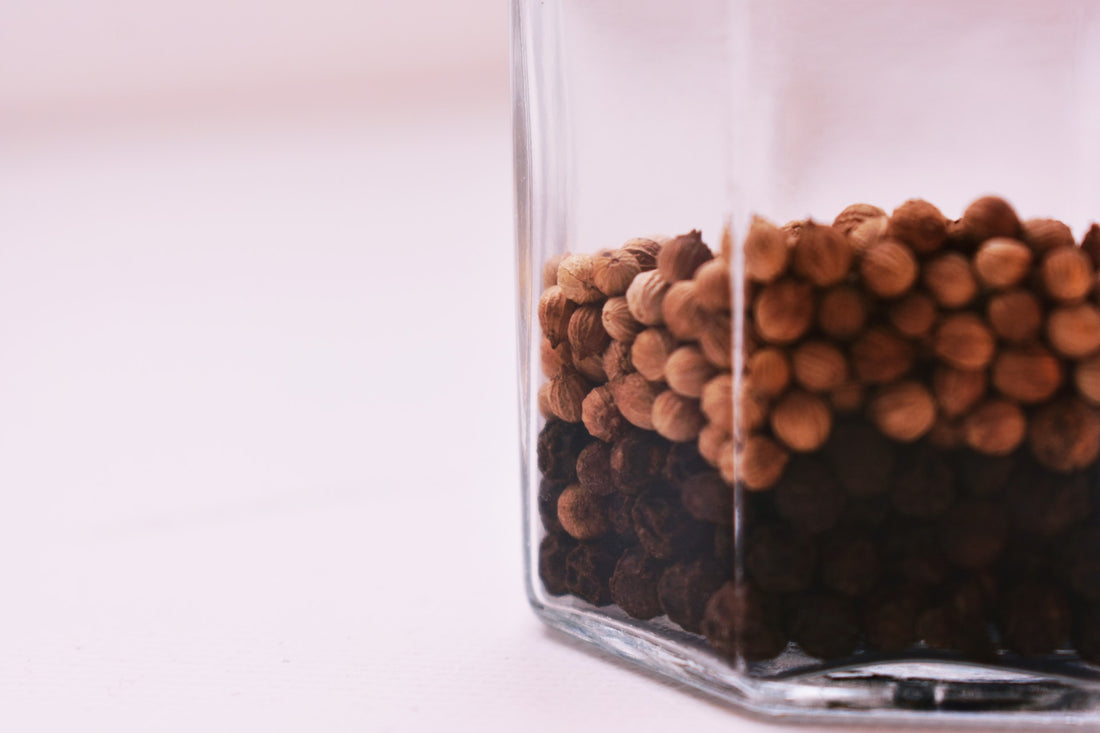
Peppercorns can bring a bit of heat and flavour to your dishes. Whether you go for finely ground with a pepper mill or coarsely cracked for extra texture, peppercorns make an excellent seasoning for a variety of cuisines. But did you know there are different types of peppercorn, and each one has unique properties?
You may be surprised to learn that many different colour peppercorns actually come from the same plant, piper nigrum. Let’s explore what sets them apart and how to use different types of whole and ground pepper.
Black peppercorns
Black peppercorns are a staple in most kitchen cupboards. In Western cooking, ground black pepper is the go-to seasoning, and few restaurants are lacking classic salt and pepper shakers on the tables. However, this spicy berry is a popular ingredient around the world.
So what makes black peppercorns so ubiquitous?
Black peppercorns start life as berries on the pepper plant. Just before ripening, they are picked and sun-dried, resulting in a wrinkly, black outer layer. When ground, they have a robust earthy flavour with a spicy kick.
Black pepper is an affordable spice that makes a great base for dry rubs and mixed seasonings. Whether you sprinkle it over soup or crack it over slow-roasting meat, black pepper is incredibly versatile and handy to have on your spice rack.
Discover our Black Peppercorns Refill Jar here
White peppercorns
Like black peppercorns, white peppercorns come from the pepper plant. However, white pepper consists of ripe berries, which are soaked to remove the outer layer. Without the black, dried skin, their flavour is milder and earthier than that of black pepper.

Why not take a look at our previous article to learn more about the difference between black and white peppercorns?
White pepper is perfect for adding a little boost of heat in light-coloured recipes, like white sauces and mashed potatoes. You get the flavour impact without distracting visually from the dish itself. It is also a popular seasoning in Asian and Mexican cuisine.
Green peppercorns
Green peppercorns are essentially unripe black peppercorns. Picked before fully ripening, they retain a fruity flavour and a vibrant green colour. They also provide a fresher spice kick than black or white pepper.
Sometimes, green peppercorns are available dried. However, you’re more likely to find them pickled or preserved in brine. Whilst you can use a pepper mill to make the most of your black or white peppercorns, green peppercorns work well whole or chopped. Popular in French cuisine, they add a great flavour and texture to sauces, especially those accompanying steak.
You could also add green peppercorns to salad dressings and potato salads for an extra bit of tang.
Red peppercorns
Red peppercorns are the ripest of the lot! As with the previous types of pepper we’ve discussed, red peppercorns come from the pepper plant (piper nigrum). However, the berries are left to ripen fully on the vine.
Sometimes, you’ll find red peppercorns in brine, but often they are left in their natural state. Although they can be dried, there is more of a risk of spoiling because they have a higher sugar content than their underripe relatives. Their flavour is sweetly spicy.

Red peppercorns are a lot more delicate than their black and white counterparts. As such, if you want to crush them, it’s best to use a pestle and mortar rather than a pepper mill.
Pink peppercorns
Unlike the previous peppercorns on this list, pink pepper does not come from the true pepper plant, despite the name. In fact, pink peppercorns are dried berries from a South American shrub, Schinus molle, or the Peruvian pepper tree.
Similarly to red peppercorns, these berries are fragile, so it’s best not to grind them with a mill. Their soft, almost hollow structure makes them a great garnish for salads. You can scatter them whole or chop them for a rustic finish. They offer sweet yet tart flavour with delicate floral notes. For this reason, many people like to add pink peppercorns to light sauces and seafood.
Szechuan Peppercorns
Another misnomer — Szechuan peppercorns are not related to black, white, green or red peppercorns. Instead, they are dried berries from mountain ash trees found in the Szechuan province of China.
Szechuan pepper is aromatic and has a vibrant citrus-like flavour. Unlike black and white peppercorns, these berries don’t carry much heat. However, many people find that Szechuan pepper creates a tingling sensation in the mouth.
The unique aroma and flavour of these peppercorns make them an excellent ingredient for stir-frys and meat seasonings. You can use them whole or chop them into smaller pieces.
Discover our Szechuan Pepper Refill Jar 35g here
What’s the best way to season with pepper?
As you can see, different types of peppercorns bring unique flavours, aromas and textures to dishes. Knowing which sorts of cuisine each pepper pairs well with can help you take your seasoning game to the next level.
When it comes to seasoning techniques, timing can impact the effect of different peppercorns, too. For example, black peppercorn is best added to dishes during the cooking process, so its heat and flavours can infuse the rest of the ingredients.

White pepper, on the other hand, works well scattered after serving. Pink and green peppercorns also make excellent garnishes. Other ingredients may overpower their flavours and aromas if they're added to dishes during the heating process.
Whichever type of peppercorn you choose to add to your spice collection, sourcing high-quality, fresh ingredients is key. Pre-ground seasonings are convenient but tend to lose potency. Whether it’s black, white or red, grinding your pepper fresh, using a mill or pestle and mortar, will prevent the peppercorns from losing their flavour so quickly. Going for a pepper mill with an adjustable grind can help you have more control over the texture of your seasoning, too.

